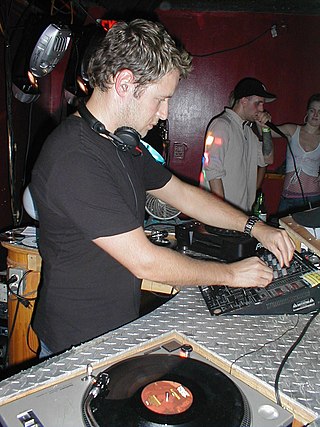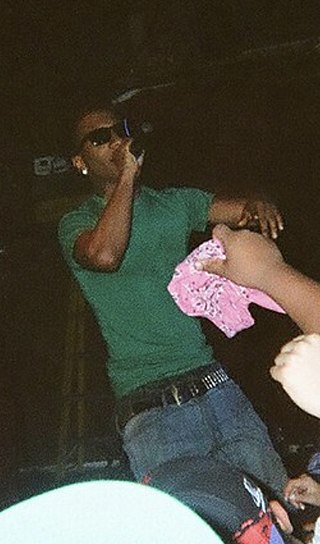Related Research Articles

Drum and bass is a genre of electronic dance music characterised by fast breakbeats with heavy bass and sub-bass lines, samples, and synthesizers. The genre grew out of the UK's jungle scene in the 1990s.
House is a sub-genre of electronic music characterized by a repetitive four-on-the-floor beat and a typical tempo of 120 beats per minute. It was created by DJs and music producers from Chicago's underground club culture in the early/mid 1980s, as DJs began altering disco songs to give them a more mechanical beat.
Outsider music is music created by self-taught or naïve musicians. The term is usually applied to musicians who have little or no traditional musical experience, who exhibit childlike qualities in their music, or who have intellectual disabilities or mental illnesses. The term was popularized in the 1990s by journalist and WFMU DJ Irwin Chusid.
Jungle is a genre of dance music that developed out of the UK rave scene and sound system culture in the 1990s. Emerging from breakbeat hardcore, the style is characterised by rapid breakbeats, heavily syncopated percussive loops, samples, and synthesised effects, combined with the deep basslines, melodies, and vocal samples found in dub, reggae and dancehall, as well as hip hop and funk. Many producers frequently sampled the "Amen break" or other breakbeats from funk and jazz recordings. Jungle was a direct precursor to the drum and bass genre which emerged in the mid-1990s.
Ghetto house or booty house is a subgenre of house music which started being recognized as a distinct style from around 1992 onwards. It features minimal 808 and 909 drum machine-driven tracks and sometimes sexually explicit lyrics.
Downtempo is a broad label for electronic music that features an atmospheric sound and slower beats than would typically be found in dance music. Closely related to ambient music but with greater emphasis on rhythm, the style may be played in chillout clubs or as "warm-up or cool-down" music during a DJ set. Examples of downtempo subgenres include trip hop, ambient house, chillwave, psybient and lo-fi hip hop.
Deep house is a subgenre of house music that originated in the 1980s, initially fusing elements of Chicago house with the lush chords of 1980s jazz-funk and touches of soul music. Its origins are attributed to the early recordings of Larry Heard, including his influential track "Can You Feel It".
Rare groove is music that is very hard to source or relatively obscure. Rare groove is primarily associated with funk, R&B and jazz funk, but is also connected to subgenres including jazz rock, reggae, Latin jazz, soul, rock music, northern soul, and disco. Vinyl records that fall into this category generally have high re-sale prices. Rare groove records have been sought by not only collectors and lovers of this type of music, but also by hip hop artists and producers.
Chill-out is a loosely defined form of popular music characterized by slow tempos and relaxed moods. The definition of "chill-out music" has evolved throughout the decades, and generally refers to anything that might be identified as a modern type of easy listening.
French house is a style of house music devised by French musicians in the 1990s. It is a form of Euro disco and a popular strand of the late 1990s and 2000s European EDM scene. The defining characteristics of the genre are filter and phaser effects both on and alongside samples from late 1970s and early 1980s European disco tracks. Tracks sometimes contained original hooks inspired by these samples, providing thicker harmonic foundations than the genre's forerunners. Most tracks in this style are in 4
4 time and feature steady four on the floor beats in the tempo range of 110–130 beats per minute. French house is similar to future funk, although there are some key differences. Purveyors of French house include Daft Punk, Stardust, Cassius, The Supermen Lovers, Modjo, Justice, and Étienne de Crécy.
Baltimore club, also called B'more club, B'more house or simply B'more, is a music genre that fuses of breakbeat and house. It was created in Baltimore, Maryland in the early to late 1990s by 2 Live Crew's Luther Campbell, Frank Ski, and DJ K-Swift, among others.

Lo-fi is a music or production quality in which elements usually regarded as imperfections in the context of a recording or performance are present, sometimes as a deliberate choice. The standards of sound quality (fidelity) and music production have evolved throughout the decades, meaning that some older examples of lo-fi may not have been originally recognized as such. Lo-fi began to be recognized as a style of popular music in the 1990s, when it became alternately referred to as DIY music.
Footwork, also called juke, footwork/juke or Chicago juke, is a genre of electronic dance music derived from ghetto house with elements of hip hop, first appearing in Chicago in the late 1990s. The music style evolved from the earlier, rapid rhythms of ghetto house, a change pioneered by RP Boo. It may draw from the rapid rhythms and sub-bass frequencies of drum & bass. Tracks also frequently feature heavily syncopated samples from rap, pop and other sources, and are often around 160 bpm.

Cloud rap is a subgenre of rap that has several sonic characteristics of trap music and lo-fi in its hazy, dreamlike and relaxed sound. Many music experts credit rapper Lil B and producer Clams Casino as the early pioneers of this style. The term "cloud rap" is related to its internet birth and its ethereal style.

Olivier J. L. Heldens is a Dutch DJ and electronic music producer from Rotterdam. He is regarded as a pioneer of the future house genre, propelling it to international attention and scoring numerous chart successes, including "Gecko (Overdrive)", "Last All Night (Koala)", "The Right Song", "Fire in My Soul", and "Turn Me On". He also produces techno songs under the alias HI-LO, which comes from "Oli H" in reversed form, and runs the label Heldeep Records. Through February 2021, he is the 460th-most-streamed artist on Spotify, with over a billion cumulative streams.

Hypnagogic pop is pop or psychedelic music that evokes cultural memory and nostalgia for the popular entertainment of the past. It emerged in the mid to late 2000s as American lo-fi and noise musicians began adopting retro aesthetics remembered from their childhood, such as radio rock, new wave pop, light rock, video game music, synth-pop, and R&B. Recordings circulated on cassette or Internet blogs and were typically marked by the use of outmoded analog equipment and DIY experimentation.
Lofi hip hop is a form of downtempo music that combines elements of hip hop and chill-out music. It was popularized in the 2010s on YouTube.
Dancehall pop is a sub-genre of the Jamaican genre dancehall that originated in the early 2000s. Developing from the sounds of reggae, dancehall pop is characteristically different in its fusion with western pop music and digital music production. Dancehall pop is also different from dancehall in that most songs use lesser Jamaican Patois in lyrics––allowing it to be globally understood and consumed. It also incorporates the key pop music elements of having melodies, hooks, and the verse-chorus format. Additionally, the genre moves away from the reggae and roots reggae music origins in social and political protest, now lyrically centering on partying, dancing, and sexuality.
Brandon Avery Perlman, known professionally as Delroy Edwards, is an American electronic musician, record producer and DJ based in Los Angeles. According to AllMusic's Paul Simpson, he produces "gritty, lo-fi house tracks as well blown-out, abstract beat tapes."
References
- 1 2 3 Wilson, Scott (22 October 2012). "Scratching the Surface: Outsider dance". Juno Plus. Retrieved 24 October 2021.
- ↑ Wilson, Scott (1 December 2016). "Has underground house finally run out of ideas?". FACT Magazine: Music News, New Music. Retrieved 2019-02-20.
- 1 2 Bakare, Lanre (13 September 2013). "How not to name a music genre". The Guardian. Retrieved 2021-10-24.
- ↑ Sherburne, Philip (26 October 2012). "Control Voltage's Friday Five: At the Fringes of the Fringes". SPIN. Retrieved 2021-10-24.
- ↑ Uhlig, Sascha (2013-10-11). "VON WEGEN AUSSENSEITER Die neue Offenheit im House". Groove (in German). Retrieved 2021-10-24.
- 1 2 Ledsham, Ed (2017-08-18). "Irony Is A Dead Scene: A User's Guide To Lo-Fi House". HighClouds. Retrieved 2019-02-20.
- ↑ Williams, Phillip (28 June 2018). "10 tracks that prove lo-fi house is more than a fad". Red Bull. Retrieved 2020-06-07.
- ↑ Plett, Cristina (2017-02-21). "Lo-Fi House: Die Revolution frisst ihre Kinder". Groove (in German). Retrieved 2021-10-24.